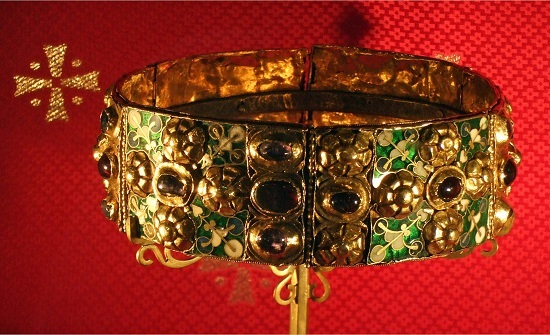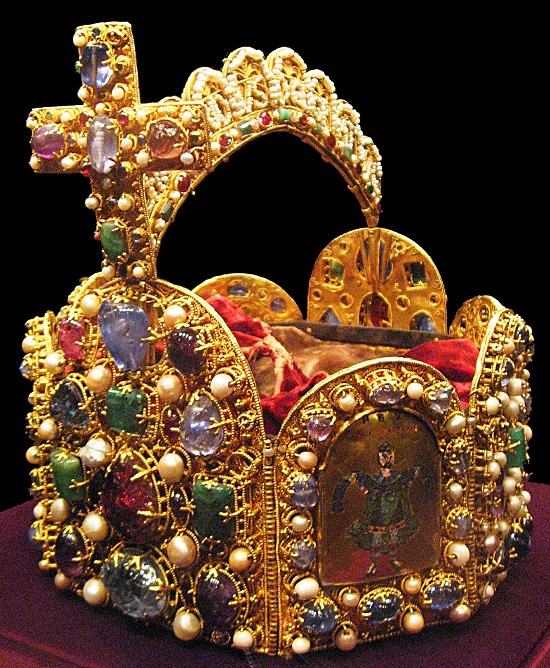By Jan Malý and Drahomír Suchánek
“Anno Domini 1355, on the Epiphany of the Lord [January 6], Lord Charles, King of Rome and Bohemia, was crowned in the city of Milan, at St. Ambrose’s Monastery, by the Archbishop of Milan, with a iron crown, usually used by Italian kings.” These were the words of Beneš Krabice of Weitmile, one of the chroniclers of the Luxembourgian era, describing the ceremonial acceptance of the ancient Lombard iron crown by the Roman and Bohemian king, Charles IV. It happened exactly 44 years after the coronation of Charles’s grandfather, Emperor Henry VII. Yet the coronation with the Italian crown was only a prelude to a much more important ceremony. Four months later, in early April 1355, Charles IV, his wife Anna of Schweidnitz, and many other members of the royal party stood upon the gates of the Eternal City, where Charles was to accept the highest secular title of the Western Christian world – the Roman Emperor.
Charles was to become the sixteenth Emperor since 962, when the East-Frankish king Otto I was adorned by the imperial diadem in St. Peter’s Basilica. In this, he followed up on the tradition that had dated back to 800. At that year, Pope Leo III placed the imperial crown upon the head of the Frankish king Charles, known to the history as Charlemagne or Charles the Great, and thus restored the Western Empire under the reign of Frankish Carolingians. And though this dynasty declined in later years, the idea of the Western Empire didn’t die out with the last Carolingian; since the late 10th century, the highest title was the ultimate goal of most Roman-German kings. From 962 till the 13th century, there was only one king who didn’t become Emperor – Stauf Conrad III in the first half of the 12th century. Later, the line of crowned Emperors was interrupted for several reasons, to be restored by Charles’s grandfather Henry VII.

The Iron crown of Lombardy (autor fota James Steakley)
Charles IV, King of Rome and Bohemia since 1346, decided to travel across the Alps in the second half of 1354. The “Roman Ride” officially started on the day of the Czech patron St. Wenceslas, September 28, in Sulzbach. He even didn’t wait for the Pope’s consent; it reached him later during the ride, already in the Italian territory. The political situation seemed to be favorable for Charles, as his great opponent, Milanese Archbishop Giovanni Visconti, had died some time before. As described in the beginning of this text, Charles was crowned the Italian king in the Dome in Milan on January 6, 1355. Though he had to promise to the Pope only to stay within the city limits on the day of the coronation, he took a private tour to the most important Roman monuments, especially the most sacred relics associated with the passion of Jesus Christ. He also visited the Basilica of St. John Lateran and other important Roman sanctuaries. Having finished the tour, he welcomed the delegation of the Roman Senate in the Vatican palace, and used the papal hospitality. Early in the morning on April 5, 1355, he returned within the city walls, to march, accompanied by the city officials and many other people, to the front of St. Peter’s Basilica, where the coronation ceremony should have taken place. The streets towards the cathedral were crowded by curious people of Rome, eager to take a look at the future Emperor. Young Roman aristocrats used the opportunity and required to be knighted by the Emperor, and Charles, wishing to avoid complications and not wanting to spoil the ceremonial atmosphere, didn’t turn them down.
As tradition had it, the imperial coronation was the responsibility of the popes, who thus demonstrated their position within the Christian society, and also their relations with the imperial rulers. Yet in the 14th century, the situation changed in some ways. Since 1309, the Pope’s was in Avignon in Southern France, under the supervision of the French kings (the “Avignon Captivity”). Also the coronation of Charles IV had to be carried out in the absence of the head of the western church. Innocent VI refused to come to Rome in person, yet he commissioned three cardinals to perform the coronation. Of those three, only one took the responsibility at last – the Cardinal of Ostia, Bishop Pierre Bertrand de Colombier. However, the Pope’s absence didn’t have any significant influence on the ceremony. The imperial party entered the city near the Angelic Castle, and then moved to the venue of the coronation, i.e. St. Peter’s Basilica. At its stairs, Charles dismounted to hug and kiss Cardinal Bertrand. Then he made a wow to protect and support the Roman church, and confirmed the material rights of the Papal State. That’s where the coronation ceremony could begin.

Imperial crown
The coronation consisted of several parts; the most important of them included the royal unction with the sacred oil, and creed of the genuine Christian faith. Then the holy mass began, during which the coronation culminated – the imperial diadem was placed upon the king’s head, and he received the orb, scepter and sword. Each insignia had its meaning, and placed rights and responsibilities into the hands of the ruler, as the head of the Christian society. Let’s take a brief look at the crown, symbolizing the highest secular title. It was the early medieval jewel from the 10th century, of the octagonal shape, adorned with gemstones and Old Testament figures. The crown had been most probably first used at the imperial coronation of Otto I in 962. Since that time, it was renovated several times; today, it’s stored in the imperial treasure in Vienna. During the coronation, a mitre was placed first on future emperor’s head, then the crown. After that, the coronation of Charles’s wife Anna of Schweidnitz followed, though a bit less pompous.
When the main ceremony was over, the new Emperor and Empress led the way to Lateran for a feast. A big procession, with some 15,000 people according to the witnesses, presented a new ruler to the Christian world. Charles’s servants kept throwing gold coins into the crowd, hundreds of young man sought knighting. However, when the feast and ceremonies were over, Charles’s big day came to an abrupt end – keeping his promise to the Pope, he left the city and sought accommodation beyond the city walls. The imperial coronation in Rome was the peak of Charles’s political career; however, it wasn’t his last ceremony of this kind. Ten years later, in spring 1365, Charles was crowned once again, this time the King of Arles. And he also attended one more coronation in the Eternal City – in 1368, when his fourth wife Elisabeth of Pomerania was crowned (unlike Charles, by the Pope Urban V in person).
Rome was the coronation venue for Roman Emperors until the early 16th century. The last ruler to accept the imperial crown from the Pope’s hands on the Italian soil was Charles V of Habsburg in 1530, but in Bologna, not in Rome. Even though the tradition of Roman Rides declined in the modern times, the Holy Roman Empire preserved up to 1806.
Bibliography:
BOBKOVÁ, Lenka – BARTLOVÁ, Milena. Velké dějiny zemí koruny české IVa. Praha: Paseka, 2003.
KAVKA, František. 5.4. 1355. Korunovace Karla IV. císařem Svaté říše římské. Praha: Havran, 2002.
ŠMAHEL, František – BOBKOVÁ, Lenka. Lucemburkové. Česká koruna uprostřed Evropy. Praha: NLN, 2012.